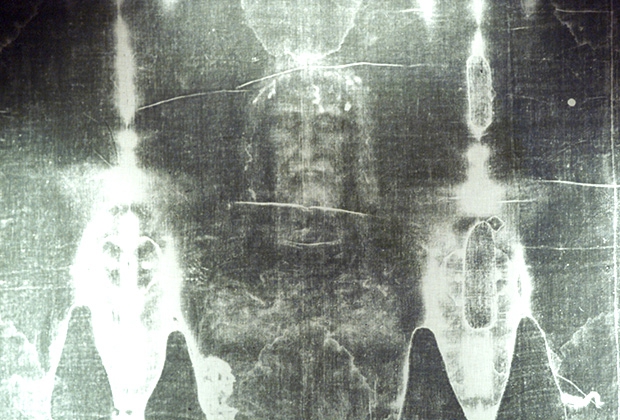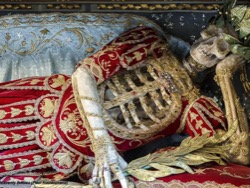
As science solves the question of the authenticity of a legendary artifact
A new study of the shroud of Turin” was supposed to settle disputes about the origin and authenticity of a legendary artifact.
India calling
For the first time with DNA evidence on a mysterious relic, the researchers faced in 1998, when I was checking for blood spots, abundantly permeated fabric. Then the scientists said the presence of iron and protein, however, potassium is not found, although his blood contains three times more than iron. After 17 years, it was organized a large-scale study of these traces of DNA, and the results published in the journal Scientific Reports. It turned out that the DNA samples belonged to both people and plants.
In particular, it has found DNA of chicory ordinary, European spruce, hops ordinary, walnut, Mediterranean white clover, cocklebur and sycamore, North American Robin monoacetate, as well as growing in the far East pear proselochnoy, Chinese hornbeam and several other plants. The researchers emphasize that some of these species in medieval Europe is not exactly met. However to do any conclusions concerning the question of the authenticity of the relic, based on the DNA sequencing of plants, the scientists could not, adding that samples from North America probably came to the relic after the opening of a new continent by Europeans.
However, the work with the alleged traces of human DNA have yielded fruit: scientists have sequenced the mitochondrial DNA (DNA that is passed from mother to child) and found that on the shroud has left a trail of very different peoples — from the North African Berbers to the Chinese.
Especially noted in the shroud taken from the mitochondrial DNA haplotype characteristic of the Druze — people living in a limited area in Syria, Jordan, Lebanon and Israel. In addition, it is reported that the oldest found samples of DNA unique to India.
This suggests that the shroud was brought to Europe from India and nothing to do with Christ has not. In favor of this interpretation and the original name of the shroud — sindon, that is, that imported from India.
Mentioned another version — taken from the Holy Land shroud could cross half the world before he got to Italy. However, evidence for the theory is much less and India, it in no way goes together. The third version: the shroud was woven in medieval Europe, and the DNA of plants and humans appeared on her thanks to the pilgrims who flocked from all over the world.
The silence of the Church
The shroud of Turin is one of the major relics of Christianity. According to legend, this piece of linen cloth with a length of 4.36 meters and a width of 1.09 metres was wrapped around Jesus Christ after his removal from the cross. The artifact is kept in the Church of St. John in Turin. The fabric is impregnated with pollen and contours of various plants. However, the main feature relics — two reddish silhouette of a man front and back. If you look closely, as say the supporters of the authenticity of the artifact, we can see the traces of the crown of thorns and wounds from torture, which has been impressed on the shroud.
For the first time the artifact mentioned in the middle of the XIV century in connection with its former owner — a French knight Zhofreem de Charny. A century later, the shroud was sold to the Italian rulers of the County of Savoie. The relic was accompanied by representatives of the Savoy dynasty in Chamberly, then in Piedmont, where she was damaged by fire in 1532 it was flooded with molten silver. Subsequently, the web is not just mended, while maintaining proper form. In Turin the artifact was moved in 1578. Until the mid-1980s, years the shroud belonged to the Savoy dynasty, and with the death of the last king of Italy Umberto II became the property of the Catholic Church.
The history of the Turin shroud before the XIV century are rather vague: for over a thousand years after Christ’s execution is similar to her description of the artifacts mentioned in separate sources. For example, one of them three centuries was the capital of the Byzantine Empire — Constantinople. Numerous studies have questioned these legendary references, and published in 2009 critical article, a French Explorer, Emanuela had not left from these legends of a stone.
The main problem for those who believe in the authenticity of the relics is that in the New Testament when describing the descent from the cross of Jesus, it is not mentioned. All four evangelists say on the shroud only at the burial of Jesus ‘ body — and no word on her fate.
Attempts to prove the authenticity of relics have been made since its discovery. However, did that in those days only the representatives of the Church who did not like that the shroud is in the hands of private people. Because the profit from exhibiting relics of the owners shared with local authorities, they did not object to this “business”, despite the protests of the Church.
Officially on the authenticity of the relic, the Catholic Church never said.
Science become enchurched
The first scientific study of the artifact was held in 1898: then the researchers found that the image made on the shroud is not paint, but rather resembles a photographic negative. Next time “access to the body” scientists have received in 80 years. Then managed to find the “hemoglobin” in the blood stains on the fabric. Further investigations showed that the alleged blood stains are ferrous ochre and cinnabar, which in the Middle ages was part of the scarlet paint.
Art analysis conducted in the 1970s, did not add points to the supporters of the authenticity of the artifact: according to critics, is depicted on the cloth silhouette meets the Canon image of Christ, formed in the XIV century and did not coincide with earlier. In particular, it says that the arms engraved on human tissue stacked on the genitals, although the Jews buried their dead with arms crossed across his chest with his hands. But it is the way of the saints portrayed from the XI century. In addition, the dead Jews had cut her hair that also does not match the silhouette on the shroud.
One of the mysteries — the age of the shroud. In determining the age of artifacts, scientists usually use physicochemical radiocarbon method, based on the decay of a radioactive isotope of carbon. Carbon has three isotopes, the heaviest of which — <sup>14</sup>C — radioactive, but its half-life exceeds 5700 years. When creating the artifact content of this isotope is comparable to atmospheric, and then diminishes due to radioactive decay. If you compare the contents <sup>14</sup>C with an easier and more stable isotope <sup>12</sup>C, we can determine the approximate date of manufacture of the artifact.
An initial study of the shroud of this method showed that it was created between 1260 and 1390 years. Fragments of the shroud was removed in the presence of scientists, and then was studied in different laboratories, several research teams. Church and then gave me a sample for research, but their withdrawal was carried out without witnesses. Subsequently, scientists have come to the critical insights of their predecessors, but are unable to refute them.
In Russia, the debate around the shroud resumed in 2001, when Russian criminalists and scientists questioned the competence of radiocarbon Dating conducted in the United States, Switzerland and the UK. Russian astronomer and popularizer of science Vladimir Surdin, published an article in which he explained that the sensational conclusions — the result of a gross mathematical mistakes made when setting up the equation the ratio of carbon isotopes.
“I try to follow the work of scientists on the shroud. This is an interesting task. I think that the origin of the canvas will soon understand completely, but the technology of drawing is still a mystery. I can reproduce something similar, skeptics fail to convince. But believers will fail after that. But this is not the problem of scientists”, — said Vladimir Surdin, to which “Tape.<url>” asked for comments in light of new research.
Thus, the team remains to answer three main questions: when and where was woven the robe and how she was marked with the appropriate figure. And if the first question researchers are trying to answer punctually, the last serious work on the print on the fabric, was published four years ago.
Vladimir Koryagin








